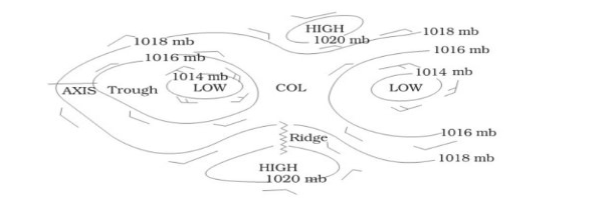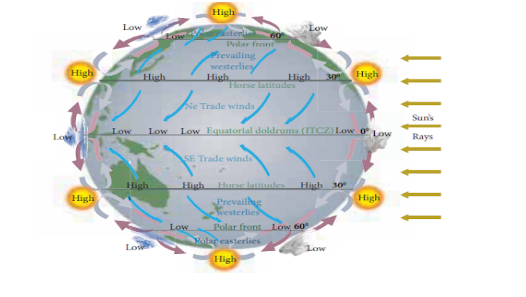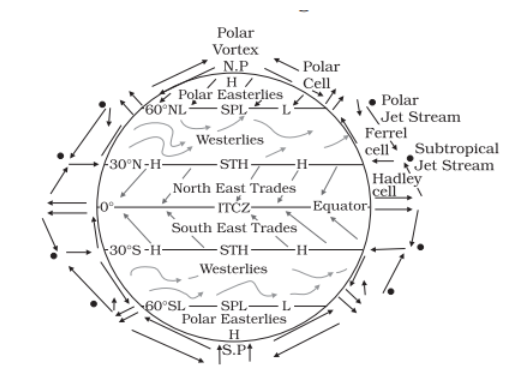Air Pressure and Atmospheric Circulation
Atmospheric pressure is the force exerted by air molecules on the Earth's surface per unit area.
- It varies due to the weight of the air above, diminishing with altitude.
- This pressure fluctuation leads to the movement of air, known as wind, from high-pressure to low-pressure regions.
- The relationship between atmospheric pressure and temperature is inversely proportional. When temperature rises, air expands and its density per unit area decreases, causing pressure to drop.
- Conversely, with lower temperatures, air contracts, leading to an increase in pressure.
- A barometer is the instrument used to measure atmospheric pressure. At sea level, the average pressure is about 1013.25 millibars (mb).
VERTICAL DISTRIBUTION OF AIR PRESSURE
- In the lower atmosphere, pressure diminishes notably as altitude increases.
- At elevated locations, such as the peak of Mt. Everest, the air pressure can be approximately two-thirds less than that at sea level.
- This decrease isn't consistent as various factors affect air density, including temperature, moisture content, and gravity.
- The general trend observes an average decrease in pressure of about 34 millibars for every 300 metres in height.
- The vertical pressure gradient force significantly surpasses the horizontal force, but it is usually counterbalanced by an opposing gravitational force, thereby preventing powerful upward winds.
- Gravity contributes to higher pressure at the surface due to denser air.
- The pressure is linked to both density and temperature, indicating that changes in either parameter will impact pressure.
- Pressure gradients from high to low pressure are the primary drivers of air movement, i.e., wind.
- Rising pressure typically heralds clear and settled weather, while falling pressure often signifies unstable and cloudy conditions.
HORIZONTAL VARIATION OF AIR PRESSURE

- The distribution of pressure across the horizontal is examined by plotting isobars, lines connecting regions with identical pressure.
- To ensure fair comparison, pressure is often measured at various stations after normalisation to sea level to negate the influence of altitude.
- The spacing between isobars illustrates both the rate and direction of pressure shifts, known as the pressure gradient.
- When isobars are closely spaced, it signifies a steep or robust pressure gradient, whereas widely spaced isobars suggest a weaker gradient.
- Pressure gradient is essentially the decrease in pressure over a specific distance in the direction where the pressure declines most rapidly.
- On the Earth's surface, there exist seven distinct horizontal pressure zones, commonly referred to as 'pressure belts'. These belts delineate regions with relatively consistent pressure patterns.

ATMOSPHERIC CIRCULATION
The atmospheric circulation pattern is delineated by three primary cells: the Hadley cell, Ferrel cell, and Polar cell. These cells govern the general circulation of the atmosphere.

1. HEDLEY CELL
- The Hadley cell, named after George Hadley who proposed the model in 1735, is formed due to the circulation of air in the Earth's atmosphere.
- At the equator, the warm air ascends because of high insolation, moves towards the poles, and descends in the subtropical regions around 30°N and 30°S latitudes.
- At the surface near the land, the air flows back toward the equator due to the pressure gradient, generating the easterly winds.
- This circulation of air and the convergence of the easterlies in the ITCZ create the Hadley cell, which includes the trade winds, the equatorial low (ITCZ), and subtropical high-pressure belts.
2. FERREL CELL
- The Ferrel cell, introduced by William Ferrel in 1856, is a component of the global atmospheric circulation pattern.
- It involves the rising of some air around the 60° latitude, moving towards the equator, descending in the subtropics, and then travelling back towards the subpolar region.
- The winds at the surface produced by this process are referred to as westerlies, and this circulation of air forms the Ferrel cell.
3. POLAR CELL
- The Polar cell involves a portion of air that rises at 60° latitude and flows towards the poles, descends, and then returns towards the subpolar region.
- The winds generated by this movement travel towards the subpolar region as the polar easterlies, defining the Polar cell.
FAQs on Atmospheric Pressure and Circulation
1. What is atmospheric pressure, and how is it measured?
Ans. Atmospheric pressure is the force exerted by air molecules per unit area on the Earth's surface. It's measured using a barometer, with an average sea-level pressure of about 1013.25 millibars (mb).
2. How does pressure vary with altitude?
Ans. As altitude increases, atmospheric pressure decreases due to the declining weight of air above. The pressure drops notably at higher elevations, like on Mount Everest.
3. Is the relationship between temperature and pressure direct or inverse?
Ans. The relationship is inverse. Higher temperatures lead to lower pressure as warm air expands and becomes less dense. Conversely, lower temperatures cause an increase in pressure due to air contraction.
4. What role do pressure gradients play in wind movement?
Ans. Air moves from regions of high pressure to low pressure, creating winds. The spacing of isobars illustrates the rate and direction of pressure shifts. Closer isobars signify a stronger pressure gradient, while wider ones indicate a weaker gradient.
5. How many major atmospheric circulation cells are there, and what are they called?
Ans. There are three primary cells: the Hadley cell, Ferrel cell, and Polar cell. These cells govern the general circulation of the Earth's atmosphere.
6. What is the Hadley cell, and how is it formed?
Ans. The Hadley cell, named after George Hadley, is created by the circulation of warm air. At the equator, warm air ascends, moves toward the poles, descends in the subtropics, and flows back toward the equator, forming the easterly winds and the ITCZ.
7. How is the Ferrel cell formed?
Ans. Proposed by William Ferrel, the Ferrel cell involves air rising around 60° latitude, moving towards the equator, descending in the subtropics, and returning to the subpolar region, creating the westerlies.
8. What defines the Polar cell?
Ans. The Polar cell involves rising air at 60° latitude, moving towards the poles, descending, and then returning towards the subpolar region, forming the polar easterlies.

